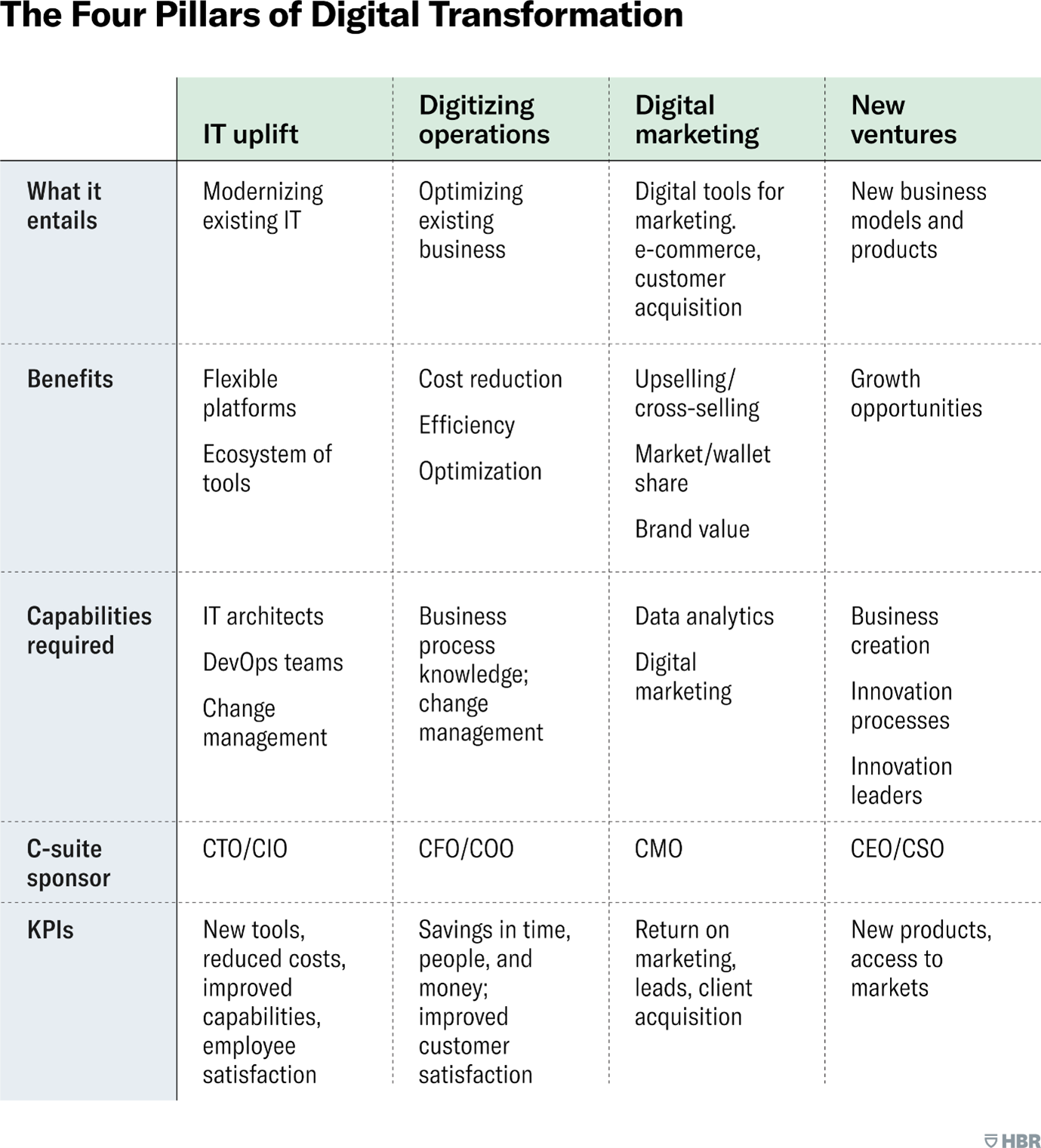As often as it is mentioned, there probably are as many definitions of digital transformation as there are people discussing it. Whatever your role in the process, be it assisting your customers with their transformational journey or taking responsibility for the whole scope or only a part of digital transformation for your organization, I found it helpful to associate the concept of digital transformation with that of a never-ending process, in which you only know where the journey begins, but not where it ends.

Why you need to embark on a digital transformation journey
Starting with the reason why an organization needs or wants to transform it can usually be narrowed down to one or several of the following reasons:
- Optimization: Improving business processes and productivity across the organization,
- Competition: Differentiating in existing markets and expanding into new ones,
- Attractiveness: Delivering better customer and user experience as well as improving employee engagement and retention,
There is plenty of room for discussion as, according to Jabil’s 2018 Digital Transformation Survey, only eight percent of respondents consider their organization as fully digitized.
It is thus important to define what an organizations intent behind going digital is. To help the discussion, I usually start with setting up a common ground of terminology so that everyone is aligned on the topics discussed. I found the definitions proposed by Peter High to be pretty much accurate and helpful in fixing concepts such as Digitization, Digitalization and Digital transformation in others minds:
Digitization is the conversion of analog or physical information to digital. Example of digitization is the conversion of instruction manuals from paper to digital, newspapers using digital channels (website, app) to deliver content, etc.
Digitalization is the use of digital technologies to enable or improve business models and processes. An example of digitalization would be providing on-site mechanics with line-of-sight digital instructions to improve efficiency and reduce errors, or newspapers expanding their offering through paywalls, videos, podcasts and VR, using analytics to drive and retain subscriptions.
Digital Transformation is the coordinated digitalization change effort at scale, diffused through all aspects of the operating model and business, including people, processes, technologies and metrics within an organization. Digital transformation in the example of a local newspaper would be to go ‘Digital First’, prioritizing digital subscriptions to support digital revenue.
Depending on an organizations digital maturity and sector of activity, we need to start off by mapping the path from the current state to the next steps in the digital transformation journey.

Mapping the digital transformation journey and elaborating where it’s leading to
Whether it starts with digitalization of one business process or creating a vision for the full-scale digital transformation of an organization, it is of utmost importance to consider the following aspects of said organization
Assess the needs – identify current and future business needs, the competitive landscape, existing technologies and skills as well as the urgency to transform. Map business value of business processes, applications and tools and weigh them against the amount of investment needed to digitize them.
Plan for the long term – digital transformation, as well as any other transformational process, takes time. Carefully plan the evolution, starting with the digitization of a single business process or application, while securing a long-term budget, and including intermediate steps. Business continuity should also be taken into account to ensure that current applications and processes will continue to function while transitioning to new ones.
Finance the journey – as digital transformation is expensive, but aims to generate even more revenue. The two main ways to generate return on investment (ROI) are cost saving and revenue increase. An organizations Digital Transformation business plan should include both elements to demonstrate RoI over time, with follow-up key-performance indicators (KPIs) to allow for progress monitoring and adjustment where and when required.
Risk management – as going digital brings its cohort of risks and threats, such as crashes or security breaches, which might impact service availability. Compliancy to national and international regulations also requires time and money. Careful risk monitoring and detection as well as mitigation strategies are critical components to any successful digital transformation journey.
Prioritization – to ensure long term success, find out which areas of digital transformation will have the biggest impact on the organizations activity and business. As in any transformation, it is important to continuously communicate on positive outcomes, like quicks wins and larger improvements in efficiency and/or agility.
For any organization, beginning the journey of digital transformation can be a daunting task, with the risk of conflicting demands from various departments, wrong resource allocation or placing the wrong people in charge and using wrong KPIs – all of which would be setting the digital transformation up for failure.

What to include in your baggage when going on a digital transformation journey
The inventory of an organizations components will play a major role in the success of digital transformation. A good starting point might be a list to cover the following:
Users – who will get value from the digital transformation? This could be an organizations taff, but also users from suppliers, partners and customers.
Experience – It is important to know the way the users interact with product and services, especially the digital native profiles, to understand and identify the gaps in the existing user experience. The digital transformation should contribute to building a coherent and attractive digital user experience.
Channels – as digital transformation may impact go-to-market strategies, it is important to identify possible digital enhancements to existing channels. Digital transformation could also create totally new delivery channels leveraging APIs and other digital means such as social media, IoT and messaging services.
Products & Services – Assessing how users interact with customer products and services, and how digital transformation might impact them is business critical. Digitalization might improve how products and services are delivered and used by users. Digital transformation can also be a source for new offers.
Technology – as an enabler of digital transformation, technology is the foundation of any digital strategy. Still, technology should be strongly connected to user needs and requirements, with the capability of monitoring the impact it has on business objectives. Technology stacks for Digital Transformation usually include connected objects (IoT), artificial intelligence (AI), cloud services (XaaS) and analytics.
Processes – identifying how business is done in customer organizations and what processes could benefit the most from digitalization is important as it drives the choice of technology. Knowing which aspects of a given business process can be improved can also make measuring improvement and return on investsment easier.
People – Most important asset in any strategy. The staff will dictate success or failure of a digital transformation strategy. Success heavily depends on people’s capability to acquire new skills and eventually adopt the new technology. They need to be onboarded using proper change management, including communication and training best practices.

How to pick up the right vehicle for your Digital Transformation journey
For any organization, beginning the journey of digital transformation can be a daunting task, with the risk of conflicting demands from various departments, wrong resource allocation or placing the wrong people in charge and using wrong KPIs – all of which would be setting the digital transformation up for failure.
The Internet is full of frameworks and methodologies to drive a successful digital transformation strategy. One I like in particular for its flexibility is the framework detailed by Harvard Business Review. HBR’s proposition is a simple framework that describes the four pillars of a successful digital transformation strategy.
As per HBR’s research, the four pillars are part of most digital transformation strategies. For each of the pillars, the framework details what it entails – benefits that can be expected, required capabilities, KPIs and the type of required C-level sponsorship. Understanding what each pillar covers and depending on the organization’s context and digital maturity, it is then easier to decide on the starting point and map the journey to digital transformation success.
IT uplift – as the upgrade of IT infrastructure is a mandatory step in any digital transformation journey. It rewards access to new tools, collection and exploit of data, lower IT cost, and improvement of overall performance and employee satisfaction. This is often the very first step of a Digital transformation journey, and it usually falls under the CIO or CTO to manage this pillar.
Digitizing operations – once existing business processes have been identified and documented, it is time to assess if and how digitalization can help optimizing them. This pillar is where digitization and digitalization occur. It also provides a competitive edge to the organization as without it, the risk of being left behind by more efficient operators is huge. Necessity to understand business requirements and operations make the CFO or COO the ideal sponsor for this pillar.
Digital marketing – this pillar deals with new acquisition channels such as the digital acquisition funnel, artificial intelligence (AI), and basically every mean to get insights about user behaviour with products and services like data science. This pillar is also in charge of omnichannel interaction with users. CMO is the logical sponsor for the digital marketing pillar.
New ventures – as digital transformation may open new opportunities for growth, it is important to consider its impact on an organization and its business model. The need for investment and agility to experiment and validate new business opportunities make the CEO or CSO the right sponsor for this pillar. This pillar requires more digital maturity than the IT uplift or digitizing operations pillars.

Digital transformation journey: the proper tools and guide
As an organization undergoes its journey to a successful digital transformation, traditional project management comes in handy, like support of project management office (PMO). But addressing the people aspect of digital transformation may require advanced change management practices.
Change management frameworks are used to manage the ‘human side of a digital transformation project. It focuses on assessing the status and ensuring proper adoption of new paradigms by all users impacted by the change. Identifying and activating proper C-level sponsorship as well as enabling mid-management to play their role as guides in the digital transformation journey is paramount.
Rodolphe Goudin
Head of Success Management
Rodolphe has two decades of experience in the telecommunications industry, spanning from system engineering over consulting to business development. Since the advent of the Software-as-a-Service model, he has specialised in change management as part of his clients’ digital transformation. He is now in charge of developing Alcatel-Lucent Enterprise success management practices and processes on a global level.





